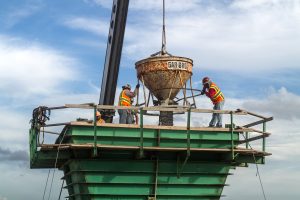Anyone who has worked in the construction industry is likely all too familiar with the term or feeling - "Under Pressure." In this article I am focusing on concrete formwork engineering pressure, that is. This article is not going to provide you with a ten step list to have a more peaceful construction related career. I will give you one generic management bite, and that is, “in construction do not let the urgent less important stuff squeeze out the important but less urgent stuff.” Now that is over, I can write about real physical pressure.
For engineering and physics purposes, pressure is simply a mass/weight divided by an area. Fluid pressure builds with the height of fluid. If a submarine goes too deep in the ocean, the fluid pressure can eventually crush the hull. Fluid pressure is calculated by simply multiplying the densify of the fluid by the depth (or height of fluid above). Back to the submarine, the pressure at 10 feet below water is 624 psf, at 1000 ft, you are at a pressure of 62,400 psf. This is also why the 10 ft long snorkel has not taken off in the vacation resorts, your lungs are not strong enough to suck in air past a depth of a couple feet.
Water is easy to visualize but not what I’d call a “common construction material”. However, soils and concrete are commonly designed with the same principle. Concrete has as a fluid has a density of about 150 lbs per cubit (larger than water), so a four foot tall wall form with wet concrete is going to have a pressure of around 600 psf at the bottom of the form. Soil has a typical fluid density of around 130 lbs per cubic foot, so a wall holding back four feet of wet fluid soil is typically modeled as having a pressure of around 520 psf at the bottom of the wall. So, all soil is not fluid like water, therefore geotechnical engineers typically account for this by providing an equivalent fluid pressure for the design. Typical values are between 30-60 lbs per cubic foot, although higher values can occur, especially, if expansive soils conditions exist. So, holding back 10 feet of soil is similar to holding back 8-10 feet of water. Holding back concrete with a height of 10 feet (all fluid) is similar to holding water with a height of 20 feet. This explains why so many forms blowout if not designed!
Remember, similar to you feeling the pressure of stacks of papers / task pile on your desk or mind, concrete, water, and soil increase in pressure with height or depth! A kiddy pool with only 1 ft of water is not a dangerous thing, but a concrete form with 4 ft of wet concrete has some significant pressure and think twice before you fill up that 20 ft tall column form or use plywood and 2x4s to hold back the slope!









